機(jī)器學(xué)習(xí) | 從0開(kāi)發(fā)大模型-譯llama3-from-scratch
最近在看一篇github上大佬的文章,從0開(kāi)始訓(xùn)練llama3,覺(jué)得對(duì)于《從0開(kāi)發(fā)大模型》有點(diǎn)幫助,于是翻譯一下,發(fā)現(xiàn)其中很多內(nèi)容當(dāng)前系列文章的知識(shí)點(diǎn)相似。原文:https://github.com/naklecha/llama3-from-scratch其中meta-llama/Meta-Llama-3-8B文件地址:https://huggingface.co/meta-llama/Meta-Llama-3-8B/tree/main/original
1、Tokenizer
原始代碼沒(méi)有實(shí)現(xiàn)tokenizer,而是使用llama3的 tokenizer.model,實(shí)現(xiàn)代碼如下:
# 執(zhí)行:pip install blobfile
# 執(zhí)行:pip install tiktoken
from pathlib import Path
import tiktoken
from tiktoken.load import load_tiktoken_bpe
tokenizer_path = "Meta-Llama-3-8B/tokenizer.model"
special_tokens = [
"<|begin_of_text|>",
"<|end_of_text|>",
"<|reserved_special_token_0|>",
"<|reserved_special_token_1|>",
"<|reserved_special_token_2|>",
"<|reserved_special_token_3|>",
"<|start_header_id|>",
"<|end_header_id|>",
"<|reserved_special_token_4|>",
"<|eot_id|>", # end of turn
] + [f"<|reserved_special_token_{i}|>"for i in range(5, 256 - 5)]
mergeable_ranks = load_tiktoken_bpe(tokenizer_path)
tokenizer = tiktoken.Encoding(
name=Path(tokenizer_path).name,
pat_str=r"(?i:'s|'t|'re|'ve|'m|'ll|'d)|[^\r\n\p{L}\p{N}]?\p{L}+|\p{N}{1,3}| ?[^\s\p{L}\p{N}]+[\r\n]*|\s*[\r\n]+|\s+(?!\S)|\s+",
mergeable_ranks=mergeable_ranks,
special_tokens={token: len(mergeable_ranks) + i for i, token in enumerate(special_tokens)},
)
print(tokenizer.decode(tokenizer.encode("hello world!")))
## 輸出
hello world!這里用了字節(jié)對(duì)編碼(BPE),和我們訓(xùn)練的tokenzier使用的方式一樣。
2、讀取模型文件
將模型文件下載到 Meta-Llama-3-8B 文件夾中,然后讀取模型文件,代碼如下:
import torch
import json
model = torch.load("Meta-Llama-3-8B/consolidated.00.pth")
print(json.dumps(list(model.keys())[:20], indent=4))
with open("Meta-Llama-3-8B/params.json", "r") as f:
config = json.load(f)
print(config)
## 輸出
[
"tok_embeddings.weight",
"layers.0.attention.wq.weight",
"layers.0.attention.wk.weight",
"layers.0.attention.wv.weight",
"layers.0.attention.wo.weight",
"layers.0.feed_forward.w1.weight",
"layers.0.feed_forward.w3.weight",
"layers.0.feed_forward.w2.weight",
"layers.0.attention_norm.weight",
"layers.0.ffn_norm.weight",
"layers.1.attention.wq.weight",
"layers.1.attention.wk.weight",
"layers.1.attention.wv.weight",
"layers.1.attention.wo.weight",
"layers.1.feed_forward.w1.weight",
"layers.1.feed_forward.w3.weight",
"layers.1.feed_forward.w2.weight",
"layers.1.attention_norm.weight",
"layers.1.ffn_norm.weight",
"layers.2.attention.wq.weight"
]
{
'dim': 4096,
'n_layers': 32,
'n_heads': 32,
'n_kv_heads': 8,
'vocab_size': 128256,
'multiple_of': 1024,
'ffn_dim_multiplier': 1.3,
'norm_eps': 1e-05,
'rope_theta': 500000.0
}其中輸出的配置看:
- n_layers=32:表示該模型有32個(gè)Transformer層
- n_heads=32:表示每個(gè)Transformer層有32個(gè)注意力頭
- vobac_size=128256:表示詞匯表大小為128256
3、文本轉(zhuǎn)換為token
使用 tiktoken(openai的庫(kù))作為 tokenizer,實(shí)現(xiàn)如下:
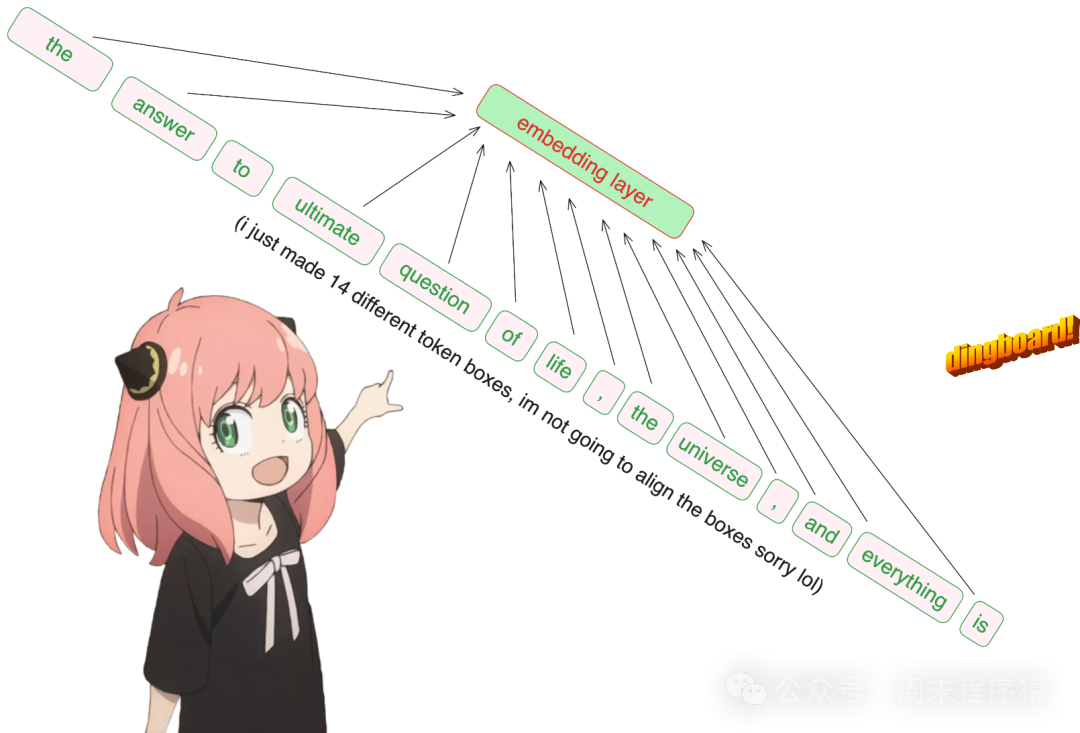
llama3-scratch
prompt = "the answer to the ultimate question of life, the universe, and everything is "
tokens = [128000] + tokenizer.encode(prompt)
print(tokens)
tokens = torch.tensor(tokens)
prompt_split_as_tokens = [tokenizer.decode([token.item()]) for token in tokens]
print(prompt_split_as_tokens)
## 輸出
[128000, 1820, 4320, 311, 279, 17139, 3488, 315, 2324, 11, 279, 15861, 11, 323, 4395, 374, 220]
['<|begin_of_text|>', 'the', ' answer', ' to', ' the', ' ultimate', ' question', ' of', ' life', ',', ' the', ' universe', ',', ' and', ' everything', ' is', ' ']其中,128000是 <|begin_of_text|> 的token,還包括如下特殊token:
"<|begin_of_text|>",
"<|end_of_text|>",
"<|reserved_special_token_0|>",
"<|reserved_special_token_1|>",
"<|reserved_special_token_2|>",
"<|reserved_special_token_3|>",
"<|start_header_id|>",
"<|end_header_id|>",
"<|reserved_special_token_4|>",
"<|eot_id|>"4、將token轉(zhuǎn)換為embedding
將上面的 token 通過(guò) embedding 層,[17X1] 轉(zhuǎn)換為 [17X4096],即 17 個(gè) embeding(每個(gè)token一個(gè)),長(zhǎng)度為 4096。
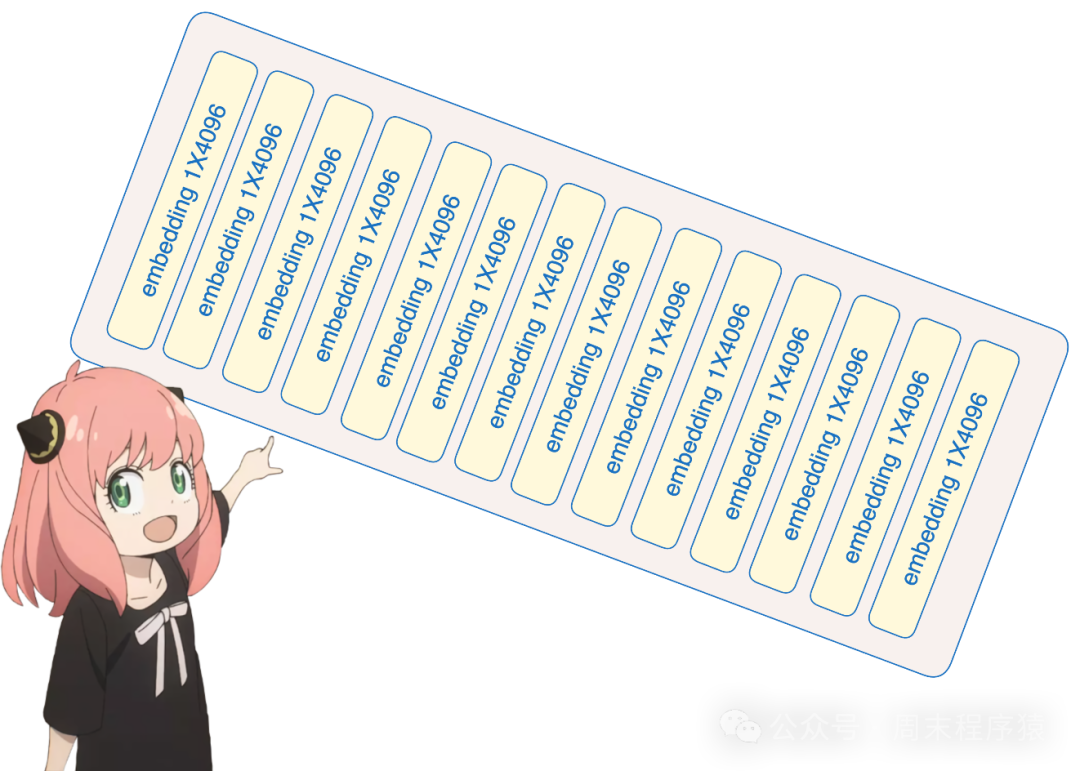
llama3-scratch
代碼如下:
embedding_layer = torch.nn.Embedding(vocab_size, dim)
embedding_layer.weight.data.copy_(model["tok_embeddings.weight"])
token_embeddings_unnormalized = embedding_layer(tokens).to(torch.bfloat16)
token_embeddings_unnormalized.shape
## 輸出
torch.Size([17, 4096])5、使用RMS對(duì)embedding進(jìn)行歸一化
當(dāng)前步驟不會(huì)改變形狀,只是做標(biāo)準(zhǔn)化處理,需要用到norm_eps,代碼如下:
def rms_norm(tensor, norm_weights):
return (tensor * torch.rsqrt(tensor.pow(2).mean(-1, keepdim=True) + norm_eps)) * norm_weights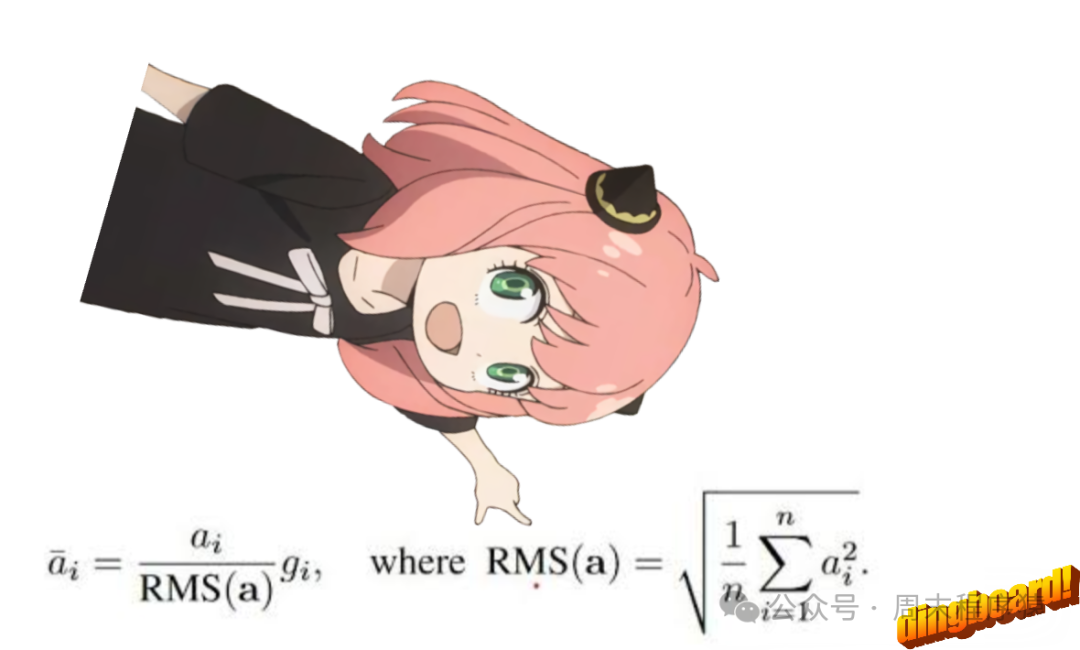
llama3-scratch
6、構(gòu)建Transformer第一層
6.1、歸一化
獲取模型的第一層權(quán)重(layer.0),進(jìn)行歸一化處理:
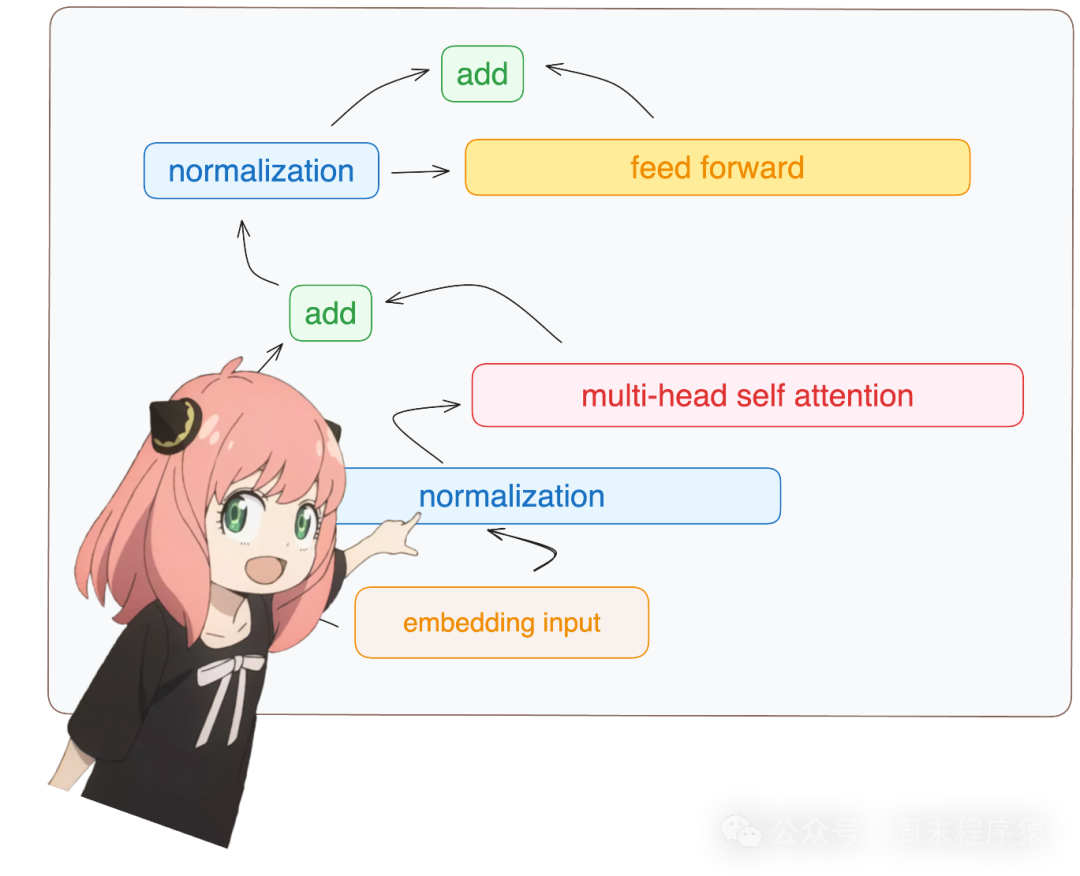
llama3-scratch
token_embeddings = rms_norm(token_embeddings_unnormalized, model["layers.0.attention_norm.weight"])
token_embeddings.shape
## 輸出
torch.Size([17, 4096])6.2、注意力機(jī)制
先加載Transformer的第一層注意力頭:
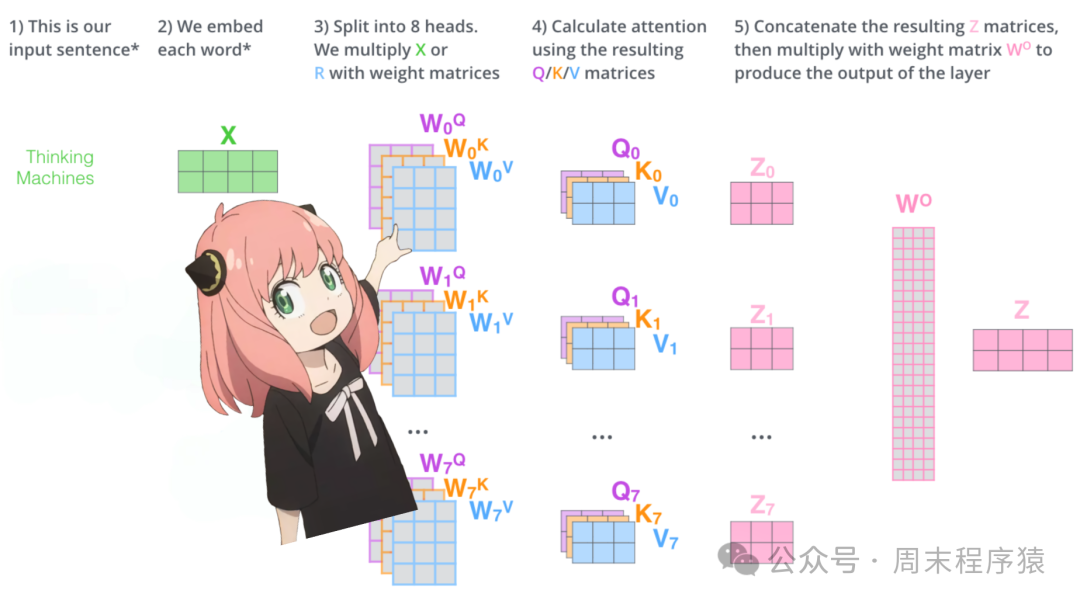
llama3-scratch
- 從模型中加載wq,wk,wv,wo的權(quán)重,分別是[4096X4096],[1024X4096],[1024X4096],[4096X4096]
- 乍一看這很奇怪,因?yàn)槔硐肭闆r下我們希望每個(gè)頭部的每個(gè) q、k、v 和 o 單獨(dú)存在
- 代碼的作者將它們捆綁在一起,因?yàn)樗兄诓⑿谢⒁饬︻^部乘法
print(
model["layers.0.attention.wq.weight"].shape,
model["layers.0.attention.wk.weight"].shape,
model["layers.0.attention.wv.weight"].shape,
model["layers.0.attention.wo.weight"].shape
)
## 輸出
torch.Size([4096, 4096]) torch.Size([1024, 4096]) torch.Size([1024, 4096]) torch.Size([4096, 4096])6.3、展開(kāi)query
將多個(gè)注意力頭展開(kāi)query,可以得到的形狀為 [32X128X4096],其中32是llama3的頭數(shù),128是查詢向量的大小,4096是token emebdding的大小,代碼如下:
q_layer0 = model["layers.0.attention.wq.weight"]
head_dim = q_layer0.shape[0] // n_heads
q_layer0 = q_layer0.view(n_heads, head_dim, dim)
q_layer0.shape
## 輸出
torch.Size([32, 128, 4096])6.4、實(shí)現(xiàn)第一層的第一個(gè)head
訪問(wèn)第一層的query權(quán)重矩陣第一個(gè)head,權(quán)重矩陣的大小是[128x4096],打印一下:
q_layer0_head0 = q_layer0[0]
q_layer0_head0.shape
## 輸出
torch.Size([128, 4096])6.5、query權(quán)重和token embedding相乘
token embeding的形狀是[17x128],這是因?yàn)槲覀冇?7個(gè)標(biāo)記,每個(gè)標(biāo)記都有一個(gè)128長(zhǎng)度的查詢,將查詢的權(quán)重和token embeding層相乘,代碼如下:
q_per_token = torch.matmul(token_embeddings, q_layer0_head0.T)
q_per_token.shape
## 輸出
torch.Size([17, 128])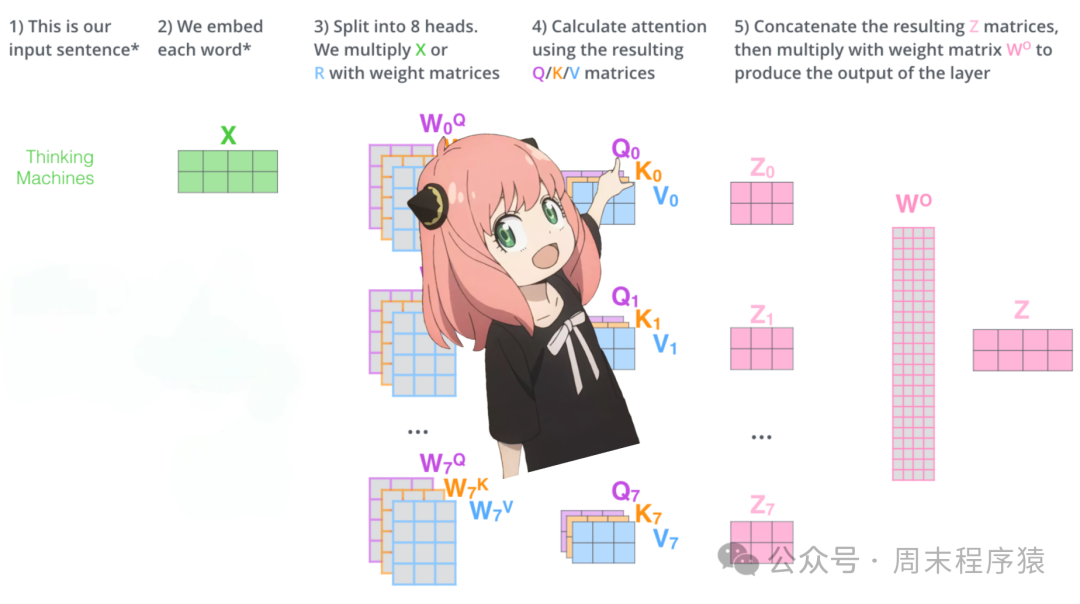
llama3-scratch
6.6、位置編碼
當(dāng)前階段我們的token都有一個(gè)query向量,但是仔細(xì)想想——單獨(dú)的query向量根本不知道提示詞的位置,比如:
query: "the answer to the ultimate question of life, the universe, and everything is "
在 prompt 中,使?了三次 "the" ,需要根據(jù)它們?cè)趐rompt中的位置為每個(gè) "the" token ?成不同的query向量(每個(gè)?度為 128),可以使? RoPE (旋轉(zhuǎn)位置編碼)來(lái)實(shí)現(xiàn)這?點(diǎn),具體RoPE實(shí)現(xiàn)可以參考之前的文章,也可以看看這個(gè)視頻:https://www.youtube.com/watch?v=o29P0Kpobz0&t=530s。
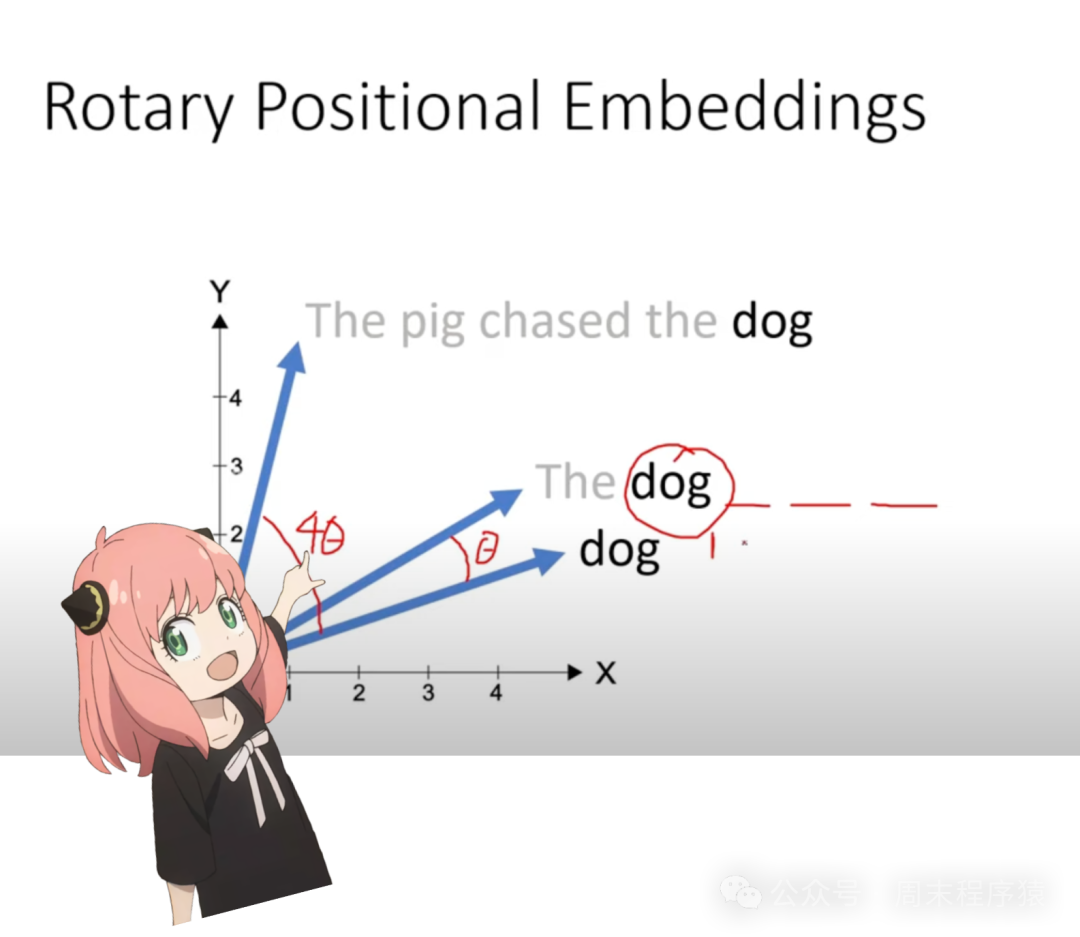
llama3-scratch
q_per_token_split_into_pairs = q_per_token.float().view(q_per_token.shape[0], -1, 2)
q_per_token_split_into_pairs.shape
## 輸出
torch.Size([17, 64, 2])從上面的步驟中,將query向量分成幾對(duì),每對(duì)使用旋轉(zhuǎn)角度移位,現(xiàn)在將一個(gè)大小為[17X64X2]的向量,這個(gè)是prompt中每個(gè)標(biāo)記分成64對(duì)的128個(gè)長(zhǎng)度的query向量, 64對(duì)中的每一對(duì)都將旋轉(zhuǎn) m*theta,其中 m 是我們要旋轉(zhuǎn)查詢的 token 位置。
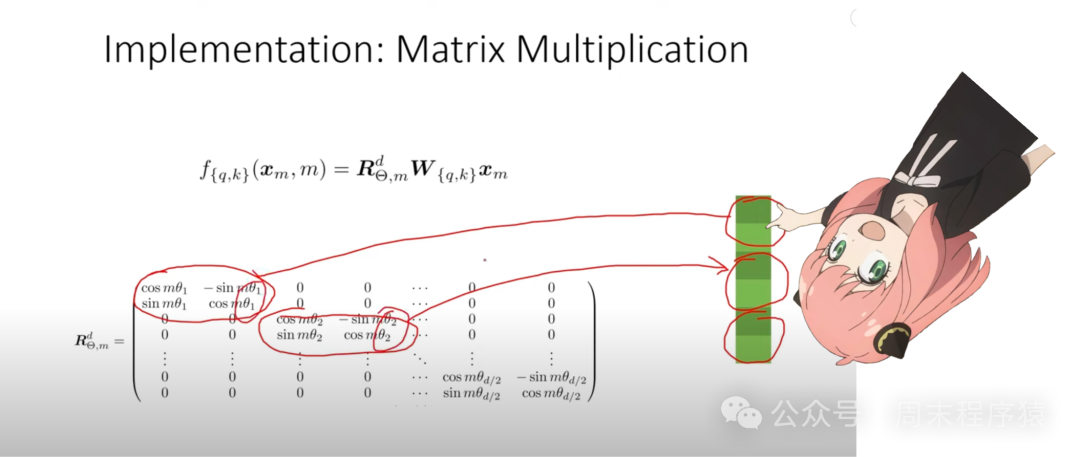
llama3-scratch
6.7、復(fù)數(shù)的點(diǎn)積來(lái)計(jì)算旋轉(zhuǎn)向量
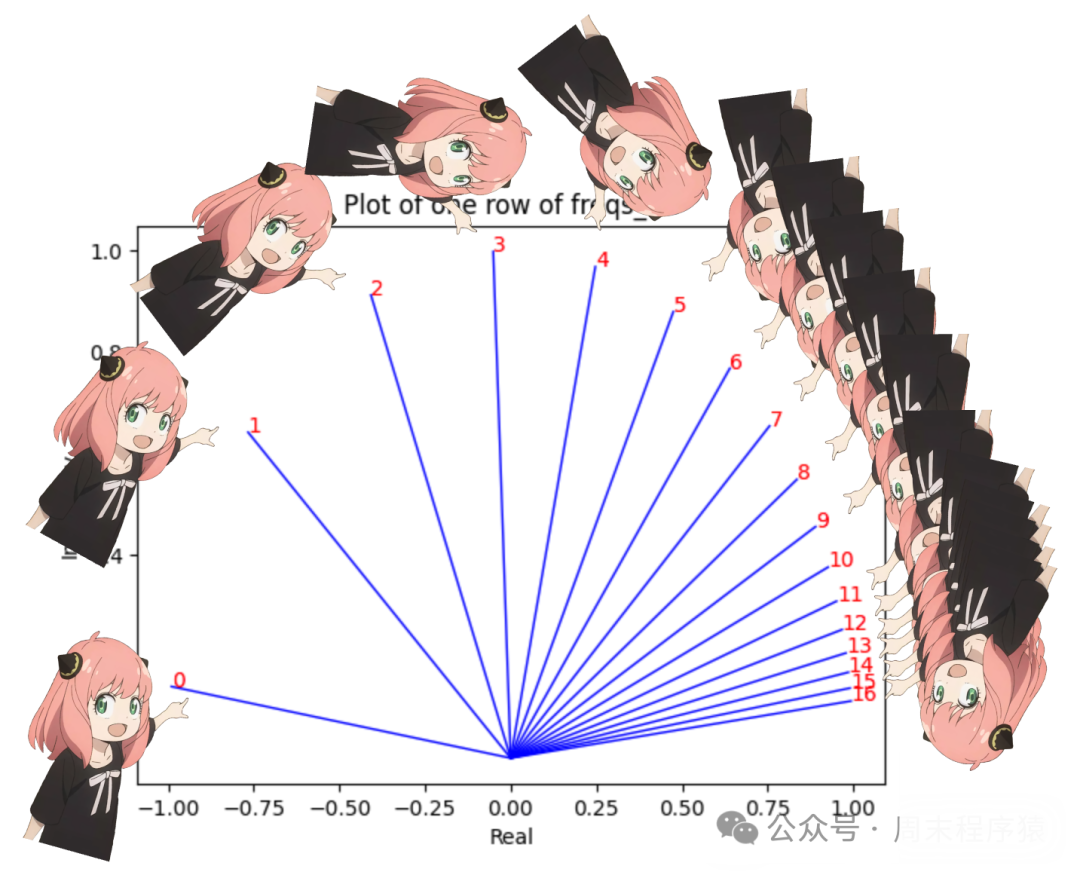
llama3-scratch
zero_to_one_split_into_64_parts = torch.tensor(range(64))/64
zero_to_one_split_into_64_parts
## 輸出
tensor([0.0000, 0.0156, 0.0312, 0.0469, 0.0625, 0.0781, 0.0938, 0.1094, 0.1250,
0.1406, 0.1562, 0.1719, 0.1875, 0.2031, 0.2188, 0.2344, 0.2500, 0.2656,
0.2812, 0.2969, 0.3125, 0.3281, 0.3438, 0.3594, 0.3750, 0.3906, 0.4062,
0.4219, 0.4375, 0.4531, 0.4688, 0.4844, 0.5000, 0.5156, 0.5312, 0.5469,
0.5625, 0.5781, 0.5938, 0.6094, 0.6250, 0.6406, 0.6562, 0.6719, 0.6875,
0.7031, 0.7188, 0.7344, 0.7500, 0.7656, 0.7812, 0.7969, 0.8125, 0.8281,
0.8438, 0.8594, 0.8750, 0.8906, 0.9062, 0.9219, 0.9375, 0.9531, 0.9688,
0.9844])
freqs = 1.0 / (rope_theta ** zero_to_one_split_into_64_parts)
freqs
## 輸出
tensor([1.0000e+00, 8.1462e-01, 6.6360e-01, 5.4058e-01, 4.4037e-01, 3.5873e-01,
2.9223e-01, 2.3805e-01, 1.9392e-01, 1.5797e-01, 1.2869e-01, 1.0483e-01,
8.5397e-02, 6.9566e-02, 5.6670e-02, 4.6164e-02, 3.7606e-02, 3.0635e-02,
2.4955e-02, 2.0329e-02, 1.6560e-02, 1.3490e-02, 1.0990e-02, 8.9523e-03,
7.2927e-03, 5.9407e-03, 4.8394e-03, 3.9423e-03, 3.2114e-03, 2.6161e-03,
2.1311e-03, 1.7360e-03, 1.4142e-03, 1.1520e-03, 9.3847e-04, 7.6450e-04,
6.2277e-04, 5.0732e-04, 4.1327e-04, 3.3666e-04, 2.7425e-04, 2.2341e-04,
1.8199e-04, 1.4825e-04, 1.2077e-04, 9.8381e-05, 8.0143e-05, 6.5286e-05,
5.3183e-05, 4.3324e-05, 3.5292e-05, 2.8750e-05, 2.3420e-05, 1.9078e-05,
1.5542e-05, 1.2660e-05, 1.0313e-05, 8.4015e-06, 6.8440e-06, 5.5752e-06,
4.5417e-06, 3.6997e-06, 3.0139e-06, 2.4551e-06])
freqs_for_each_token = torch.outer(torch.arange(17), freqs)
freqs_cis = torch.polar(torch.ones_like(freqs_for_each_token), freqs_for_each_token)
freqs_cis.shape
## 輸出
torch.Size([17, 64])6.8、現(xiàn)在在每個(gè)token的query元素都有?個(gè)復(fù)數(shù)(角度變化向量)
我們可以將 query(分成兩對(duì)的查詢)轉(zhuǎn)換為復(fù)數(shù),然后使用點(diǎn)積根據(jù)位置旋轉(zhuǎn)查詢,代碼如下:
q_per_token_as_complex_numbers = torch.view_as_complex(q_per_token_split_into_pairs)
q_per_token_as_complex_numbers.shape
## 輸出
torch.Size([17, 64])
q_per_token_as_complex_numbers_rotated = q_per_token_as_complex_numbers * freqs_cis
q_per_token_as_complex_numbers_rotated.shape
# 輸出
torch.Size([17, 64])6.9、獲得旋轉(zhuǎn)后的向量
可以通過(guò)再次將復(fù)數(shù)看作實(shí)數(shù)來(lái)返回成對(duì)的 query,代碼如下:
q_per_token_split_into_pairs_rotated = torch.view_as_real(q_per_token_as_complex_numbers_rotated)
q_per_token_split_into_pairs_rotated.shape
# 輸出
torch.Size([17, 64, 2])旋轉(zhuǎn)對(duì)現(xiàn)在已合并,現(xiàn)在有了?個(gè)新的query向量(旋轉(zhuǎn)query向量),其shape為[17x128],其中17是token的數(shù)量,128是query向量的維度。
q_per_token_rotated = q_per_token_split_into_pairs_rotated.view(q_per_token.shape)
q_per_token_rotated.shape
# 輸出
torch.Size([17, 128])6.10、keys(操作query一樣)
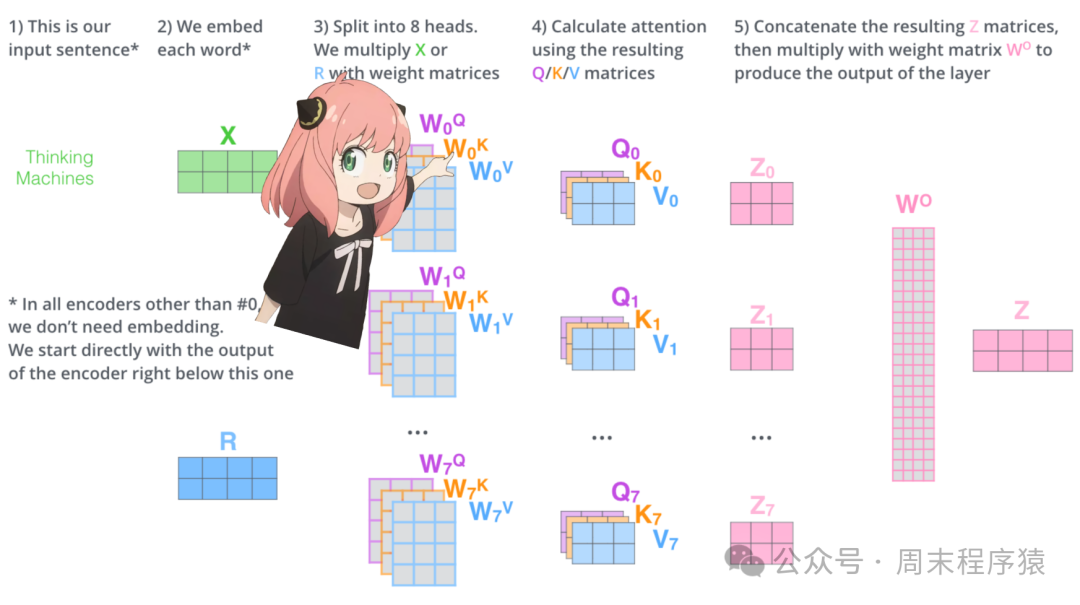
llama3-scratch
我太懶了,所以我不打算對(duì)key進(jìn)行數(shù)學(xué)運(yùn)算,唯一需要記住的是:
- key生成的key向量是128維
- key的權(quán)重?cái)?shù)量只有查詢的1/4,因?yàn)閗ey的權(quán)重一次在4個(gè)頭部之間共享,以減少所需的計(jì)算次數(shù)
- key也會(huì)選擇添加位置信息,和查詢一樣
k_layer0 = model["layers.0.attention.wk.weight"]
k_layer0 = k_layer0.view(n_kv_heads, k_layer0.shape[0] // n_kv_heads, dim)
k_layer0.shape
## 輸出
torch.Size([8, 128, 4096])
k_layer0_head0 = k_layer0[0]
k_layer0_head0.shape
## 輸出
torch.Size([128, 4096])
k_per_token = torch.matmul(token_embeddings, k_layer0_head0.T)
k_per_token.shape
## 輸出
torch.Size([17, 128])
k_per_token_split_into_pairs = k_per_token.float().view(k_per_token.shape[0], -1, 2)
k_per_token_split_into_pairs.shape
## 輸出
torch.Size([17, 64, 2])
k_per_token_as_complex_numbers = torch.view_as_complex(k_per_token_split_into_pairs)
k_per_token_as_complex_numbers.shape
## 輸出
torch.Size([17, 64])
k_per_token_split_into_pairs_rotated = torch.view_as_real(k_per_token_as_complex_numbers * freqs_cis)
k_per_token_split_into_pairs_rotated.shape
## 輸出
torch.Size([17, 64, 2])
k_per_token_rotated = k_per_token_split_into_pairs_rotated.view(k_per_token.shape)
k_per_token_rotated.shape
## 輸出
torch.Size([17, 128])完成當(dāng)前步驟,每個(gè)token的query和key都是[17X128]維度。
6.11、將query和key相乘
這樣做會(huì)給我們一個(gè)分?jǐn)?shù),將每個(gè)token相互映射,這個(gè)分?jǐn)?shù)描述了每個(gè)token的查詢與每個(gè)token的鍵的關(guān)聯(lián)程度,這是自我注意力。注意力得分矩陣 (qk_per_token) 的形狀是 [17x17],其中17是提示中的token數(shù)量。
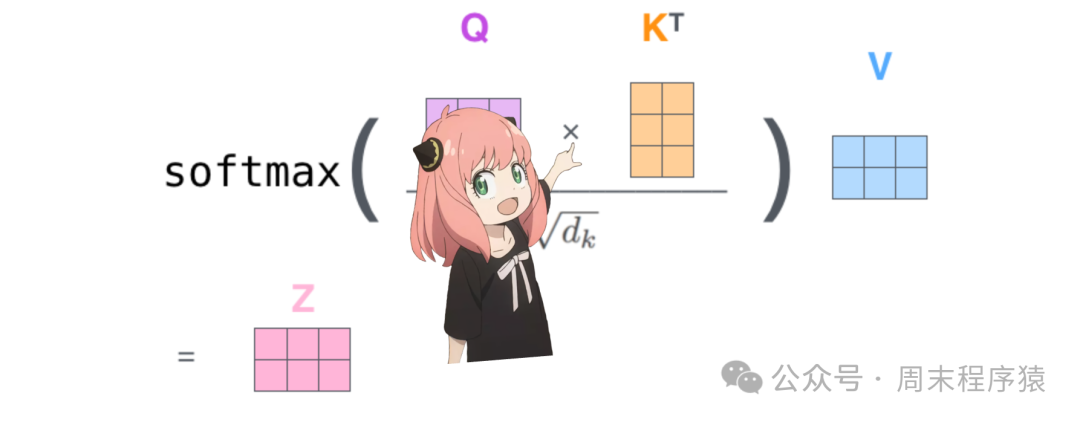
llama3-scratch
qk_per_token = torch.matmul(q_per_token_rotated, k_per_token_rotated.T)/(head_dim)**0.5
qk_per_token.shape
## 輸出
torch.Size([17, 17])7、屏蔽QK分?jǐn)?shù)
7.1、屏蔽預(yù)測(cè)的token
在llama3的訓(xùn)練過(guò)程中,未來(lái)的token qk分?jǐn)?shù)被屏蔽,為什么?因?yàn)樵谟?xùn)練過(guò)程中,只學(xué)習(xí)使?過(guò)去的token來(lái)預(yù)測(cè)token,因此,在推理過(guò)程中,將未來(lái)的token設(shè)置為零。
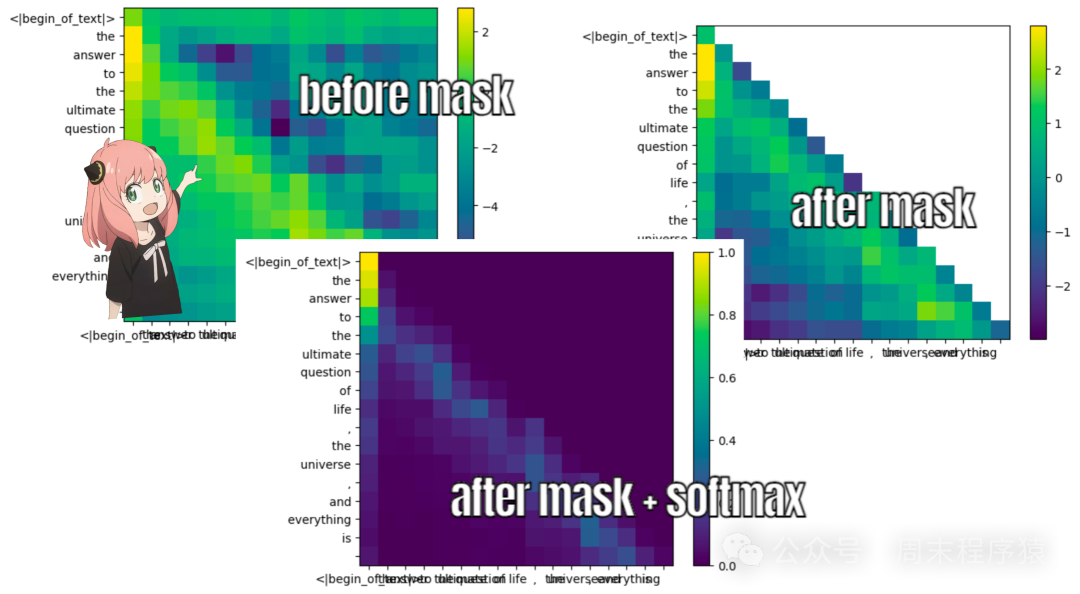
llama3-scratch
執(zhí)行如下代碼輸出:
def display_qk_heatmap(qk_per_token):
_, ax = plt.subplots()
im = ax.imshow(qk_per_token.to(float).detach(), cmap='viridis')
ax.set_xticks(range(len(prompt_split_as_tokens)))
ax.set_yticks(range(len(prompt_split_as_tokens)))
ax.set_xticklabels(prompt_split_as_tokens)
ax.set_yticklabels(prompt_split_as_tokens)
ax.figure.colorbar(im, ax=ax)
display_qk_heatmap(qk_per_token)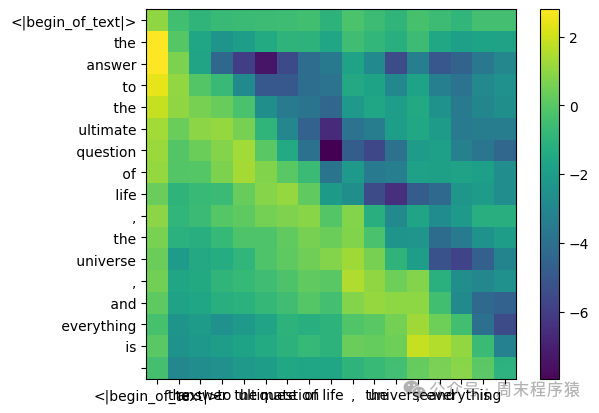
llama3-scratch
mask = torch.full((len(tokens), len(tokens)), float("-inf"), device=tokens.device)
mask = torch.triu(mask, diagnotallow=1)
mask
## 輸出
tensor([[0., -inf, -inf, -inf, -inf, -inf, -inf, -inf, -inf, -inf, -inf, -inf, -inf, -inf, -inf, -inf, -inf],
[0., 0., -inf, -inf, -inf, -inf, -inf, -inf, -inf, -inf, -inf, -inf, -inf, -inf, -inf, -inf, -inf],
[0., 0., 0., -inf, -inf, -inf, -inf, -inf, -inf, -inf, -inf, -inf, -inf, -inf, -inf, -inf, -inf],
[0., 0., 0., 0., -inf, -inf, -inf, -inf, -inf, -inf, -inf, -inf, -inf, -inf, -inf, -inf, -inf],
[0., 0., 0., 0., 0., -inf, -inf, -inf, -inf, -inf, -inf, -inf, -inf, -inf, -inf, -inf, -inf],
[0., 0., 0., 0., 0., 0., -inf, -inf, -inf, -inf, -inf, -inf, -inf, -inf, -inf, -inf, -inf],
[0., 0., 0., 0., 0., 0., 0., -inf, -inf, -inf, -inf, -inf, -inf, -inf, -inf, -inf, -inf],
[0., 0., 0., 0., 0., 0., 0., 0., -inf, -inf, -inf, -inf, -inf, -inf, -inf, -inf, -inf],
[0., 0., 0., 0., 0., 0., 0., 0., 0., -inf, -inf, -inf, -inf, -inf, -inf, -inf, -inf],
[0., 0., 0., 0., 0., 0., 0., 0., 0., 0., -inf, -inf, -inf, -inf, -inf, -inf, -inf],
[0., 0., 0., 0., 0., 0., 0., 0., 0., 0., 0., -inf, -inf, -inf, -inf, -inf, -inf],
[0., 0., 0., 0., 0., 0., 0., 0., 0., 0., 0., 0., -inf, -inf, -inf, -inf, -inf],
[0., 0., 0., 0., 0., 0., 0., 0., 0., 0., 0., 0., 0., -inf, -inf, -inf, -inf],
[0., 0., 0., 0., 0., 0., 0., 0., 0., 0., 0., 0., 0., 0., -inf, -inf, -inf],
[0., 0., 0., 0., 0., 0., 0., 0., 0., 0., 0., 0., 0., 0., 0., -inf, -inf],
[0., 0., 0., 0., 0., 0., 0., 0., 0., 0., 0., 0., 0., 0., 0., 0., -inf],
[0., 0., 0., 0., 0., 0., 0., 0., 0., 0., 0., 0., 0., 0., 0., 0., 0.]])
qk_per_token_after_masking = qk_per_token + mask
display_qk_heatmap(qk_per_token_after_masking)
qk_per_token_after_masking_after_softmax = torch.nn.functional.softmax(qk_per_token_after_masking, dim=1).to(torch.bfloat16)
display_qk_heatmap(qk_per_token_after_masking_after_softmax)7.2、values(注意力機(jī)制最后部分)
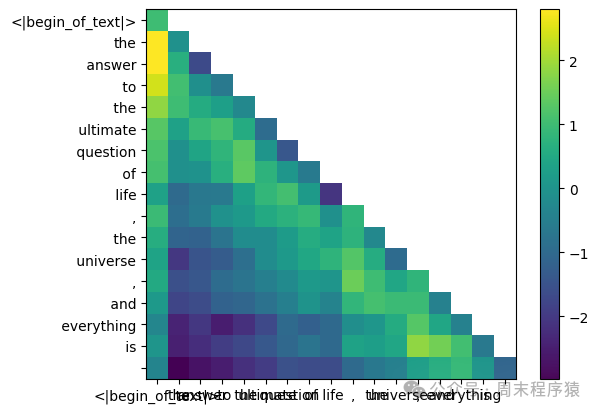
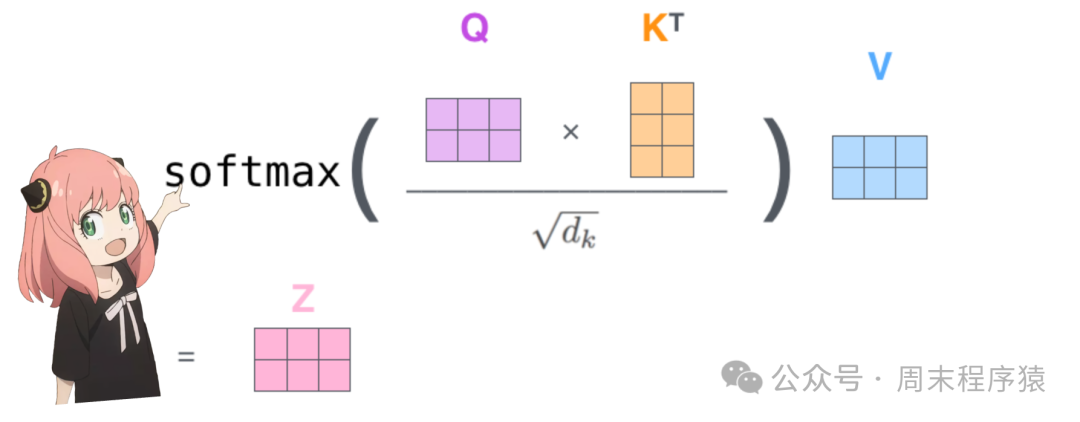
llama3-scratch
注意力分?jǐn)?shù)用于確定每個(gè)token的使用多少矩陣,就像key一樣,value的權(quán)重也是每4個(gè)注意力頭之間共享,因此value矩陣形狀是[8x128x4096]。
v_layer0 = model["layers.0.attention.wv.weight"]
v_layer0 = v_layer0.view(n_kv_heads, v_layer0.shape[0] // n_kv_heads, dim)
v_layer0.shape
## 輸出
torch.Size([8, 128, 4096])第一層,第一個(gè)頭值權(quán)重矩陣如下:
v_layer0_head0 = v_layer0[0]
v_layer0_head0.shape
## 輸出
torch.Size([128, 4096])7.3、value向量
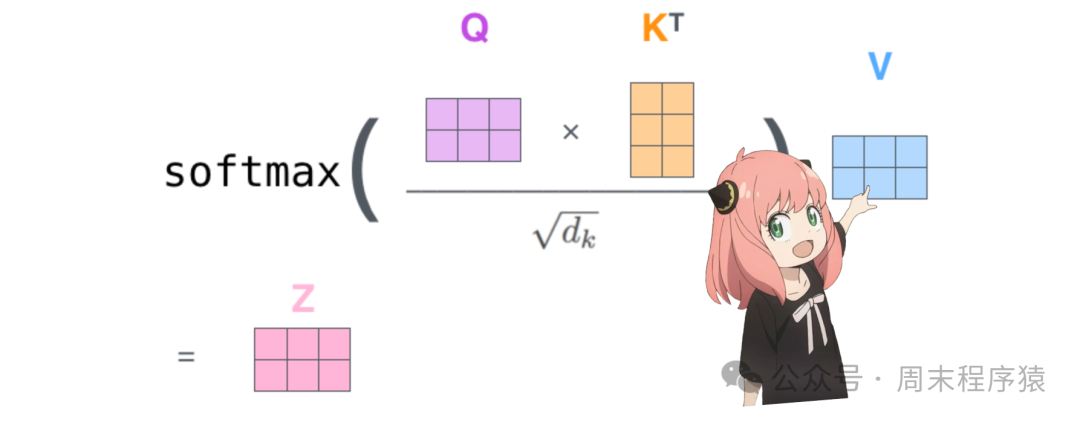
llama3-scratch
我們現(xiàn)在使用value權(quán)重來(lái)獲取每個(gè)token的注意力值,其大小為[17x128],其中17是提示中的token數(shù)量,128是每個(gè)token的值向量的大小。
v_per_token = torch.matmul(token_embeddings, v_layer0_head0.T)
v_per_token.shape
## 輸出
torch.Size([17, 128])7.4、最終的注意力輸出
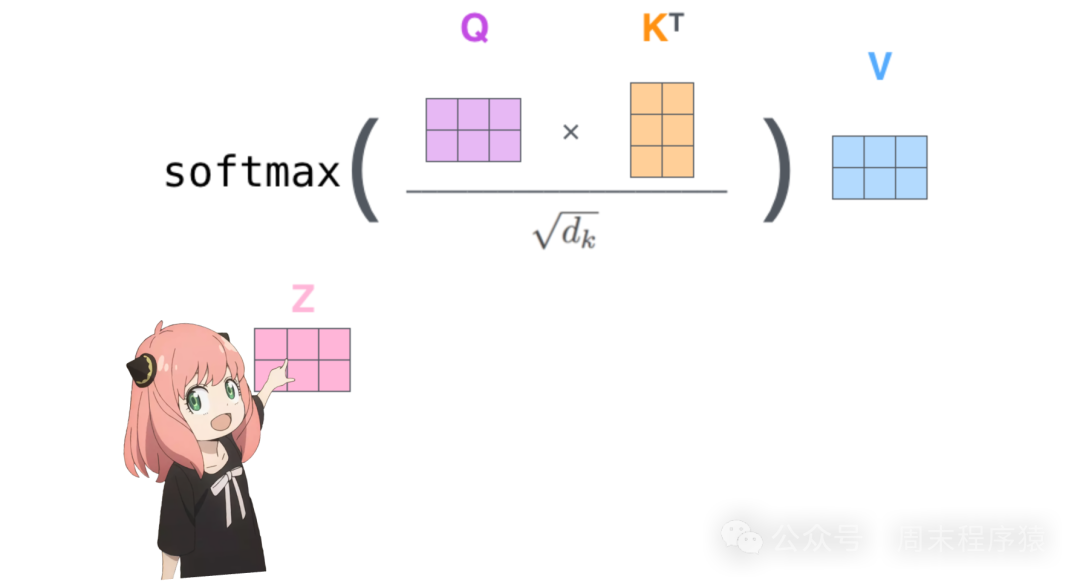
llama3-scratch
與每個(gè)token的值相乘后得到的注意向量形狀為[17*128],輸出如下:
qkv_attention = torch.matmul(qk_per_token_after_masking_after_softmax, v_per_token)
qkv_attention.shape
## 輸出
torch.Size([17, 128])8、多頭注意力機(jī)制
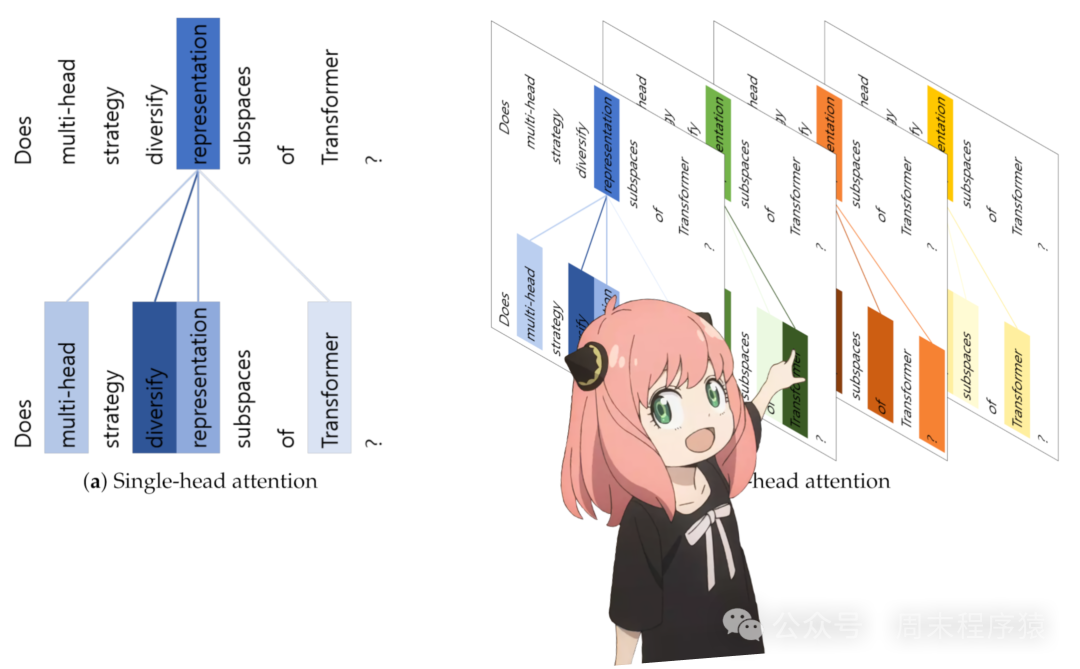
llama3-scratch
現(xiàn)在獲取了第一層和第一個(gè)頭的注意力輸出,只需要按照n_heads重復(fù)這個(gè)步驟,對(duì)第一層的每個(gè)頭部執(zhí)行與上面的單元格完全相同的數(shù)學(xué)運(yùn)算。
qkv_attention_store = []
for head in range(n_heads):
q_layer0_head = q_layer0[head]
k_layer0_head = k_layer0[head//4] # key weights are shared across 4 heads
v_layer0_head = v_layer0[head//4] # value weights are shared across 4 heads
q_per_token = torch.matmul(token_embeddings, q_layer0_head.T)
k_per_token = torch.matmul(token_embeddings, k_layer0_head.T)
v_per_token = torch.matmul(token_embeddings, v_layer0_head.T)
q_per_token_split_into_pairs = q_per_token.float().view(q_per_token.shape[0], -1, 2)
q_per_token_as_complex_numbers = torch.view_as_complex(q_per_token_split_into_pairs)
q_per_token_split_into_pairs_rotated = torch.view_as_real(q_per_token_as_complex_numbers * freqs_cis[:len(tokens)])
q_per_token_rotated = q_per_token_split_into_pairs_rotated.view(q_per_token.shape)
k_per_token_split_into_pairs = k_per_token.float().view(k_per_token.shape[0], -1, 2)
k_per_token_as_complex_numbers = torch.view_as_complex(k_per_token_split_into_pairs)
k_per_token_split_into_pairs_rotated = torch.view_as_real(k_per_token_as_complex_numbers * freqs_cis[:len(tokens)])
k_per_token_rotated = k_per_token_split_into_pairs_rotated.view(k_per_token.shape)
qk_per_token = torch.matmul(q_per_token_rotated, k_per_token_rotated.T)/(128)**0.5
mask = torch.full((len(tokens), len(tokens)), float("-inf"), device=tokens.device)
mask = torch.triu(mask, diagnotallow=1)
qk_per_token_after_masking = qk_per_token + mask
qk_per_token_after_masking_after_softmax = torch.nn.functional.softmax(qk_per_token_after_masking, dim=1).to(torch.bfloat16)
qkv_attention = torch.matmul(qk_per_token_after_masking_after_softmax, v_per_token)
qkv_attention = torch.matmul(qk_per_token_after_masking_after_softmax, v_per_token)
qkv_attention_store.append(qkv_attention)
len(qkv_attention_store)
## 輸出
32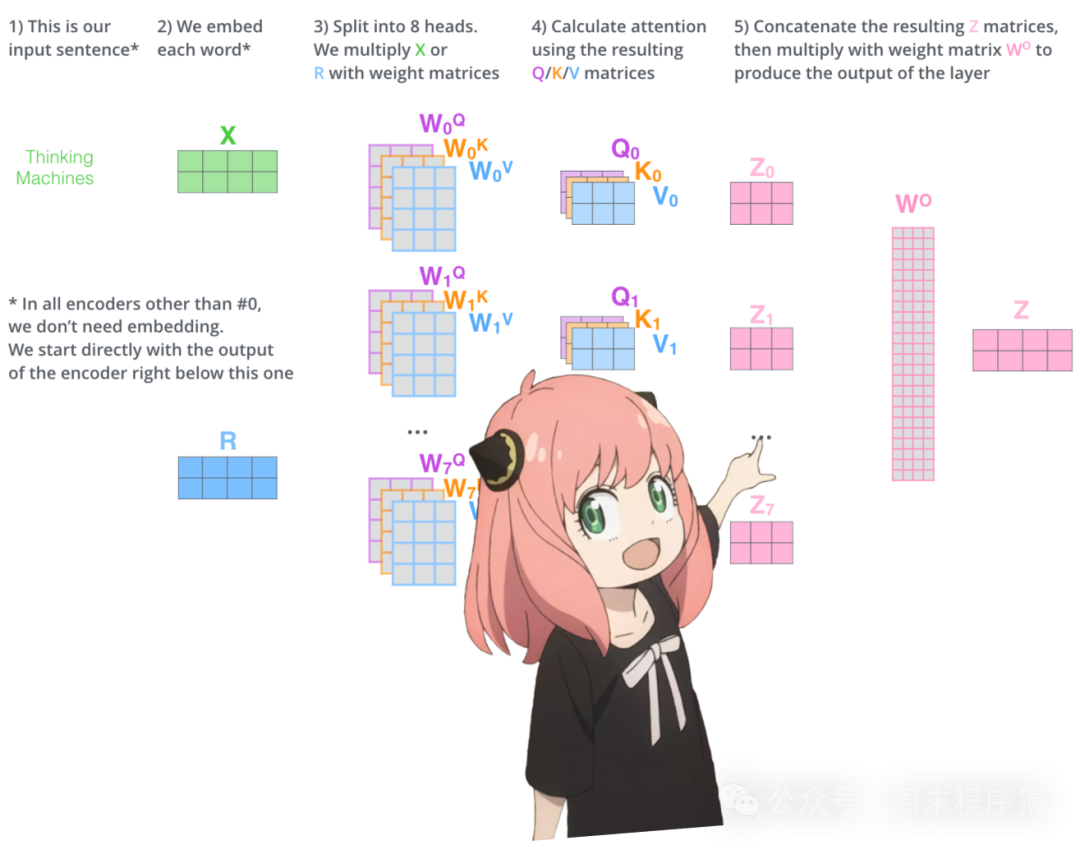
llama3-scratch
現(xiàn)在又有了第一層的32個(gè)head的qkv_attention矩陣,接下來(lái)將所有的注意力分?jǐn)?shù)合并為一個(gè)大小為[17x4096]的大矩陣,如下所示:
stacked_qkv_attention = torch.cat(qkv_attention_store, dim=-1)
stacked_qkv_attention.shape
## 輸出
torch.Size([17, 4096])9、最后一步:計(jì)算權(quán)重矩陣
對(duì)于第0層注意力,最后要做的事情之一是將權(quán)重矩陣相乘:
w_layer0 = model["layers.0.attention.wo.weight"]
w_layer0.shape
## 輸出
torch.Size([4096, 4096])9.1、簡(jiǎn)單的線性層,所以我們只需要matmul
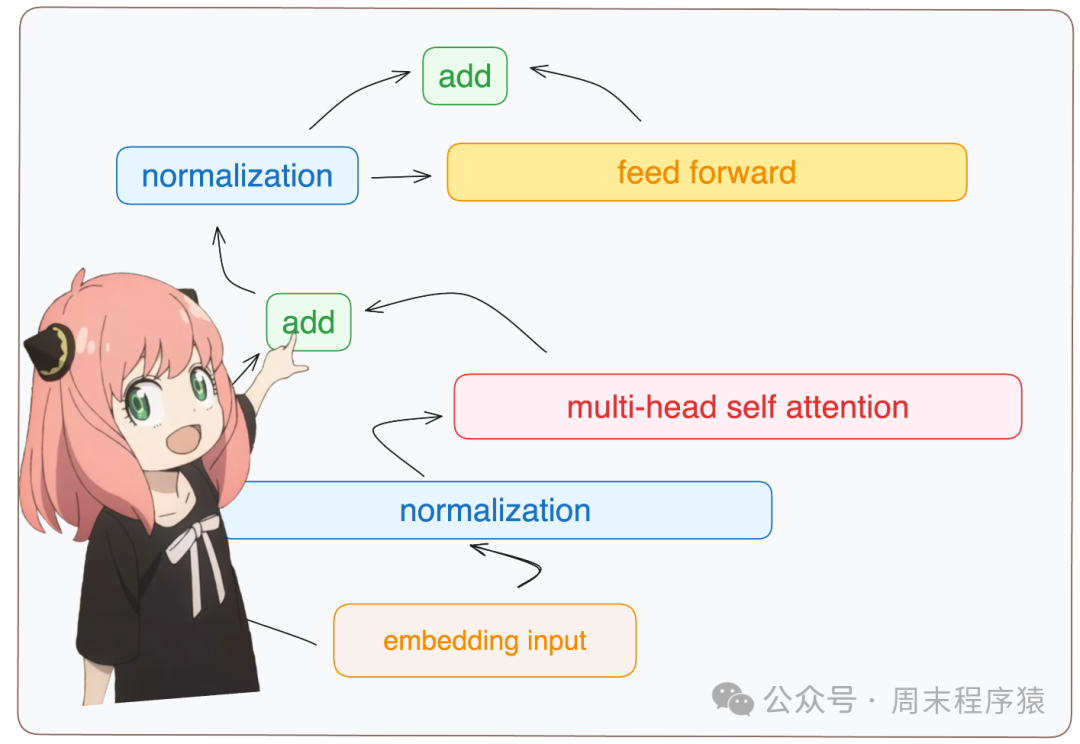
llama3-scratch
embedding_delta = torch.matmul(stacked_qkv_attention, w_layer0.T)
embedding_delta.shape
## 輸出
torch.Size([17, 4096])現(xiàn)在embeding值變化了,添加到原始的token中嵌入:
embedding_after_edit = token_embeddings_unnormalized + embedding_delta
embedding_after_edit.shape
## 輸出
torch.Size([17, 4096])9.2、歸一化,然后通過(guò)embedding增量運(yùn)??個(gè)前饋神經(jīng)?絡(luò)
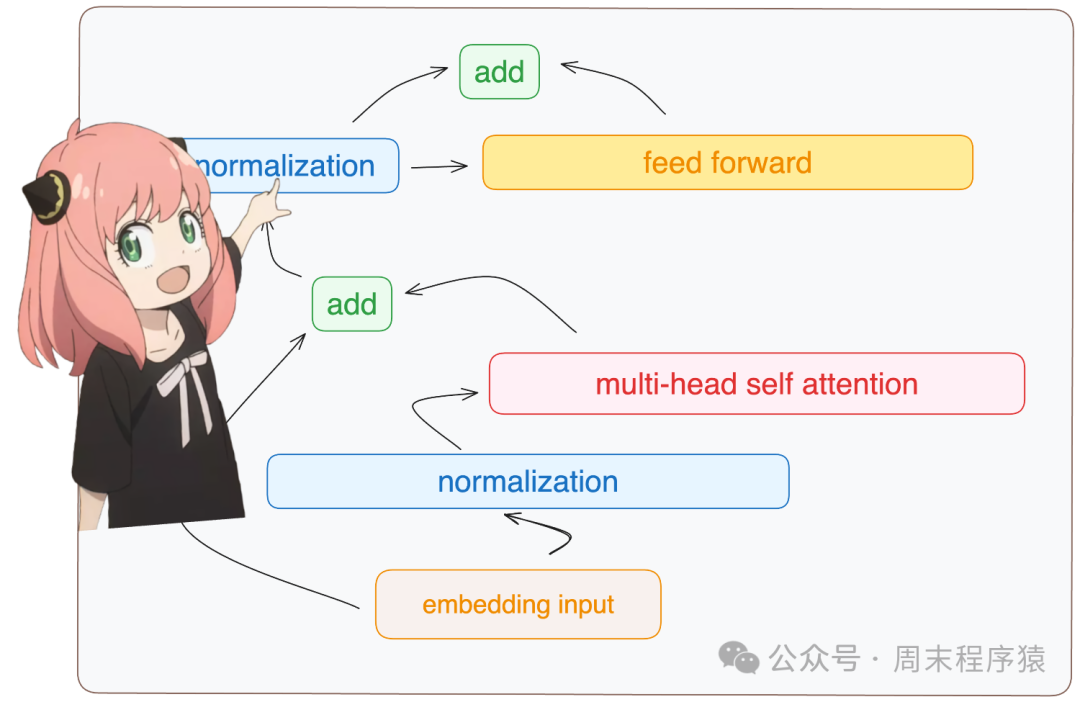
llama3-scratch
embedding_after_edit_normalized = rms_norm(embedding_after_edit, model["layers.0.ffn_norm.weight"])
embedding_after_edit_normalized.shape
## 輸出
torch.Size([17, 4096])9.3、加載FFN權(quán)重并實(shí)現(xiàn)前饋?絡(luò)
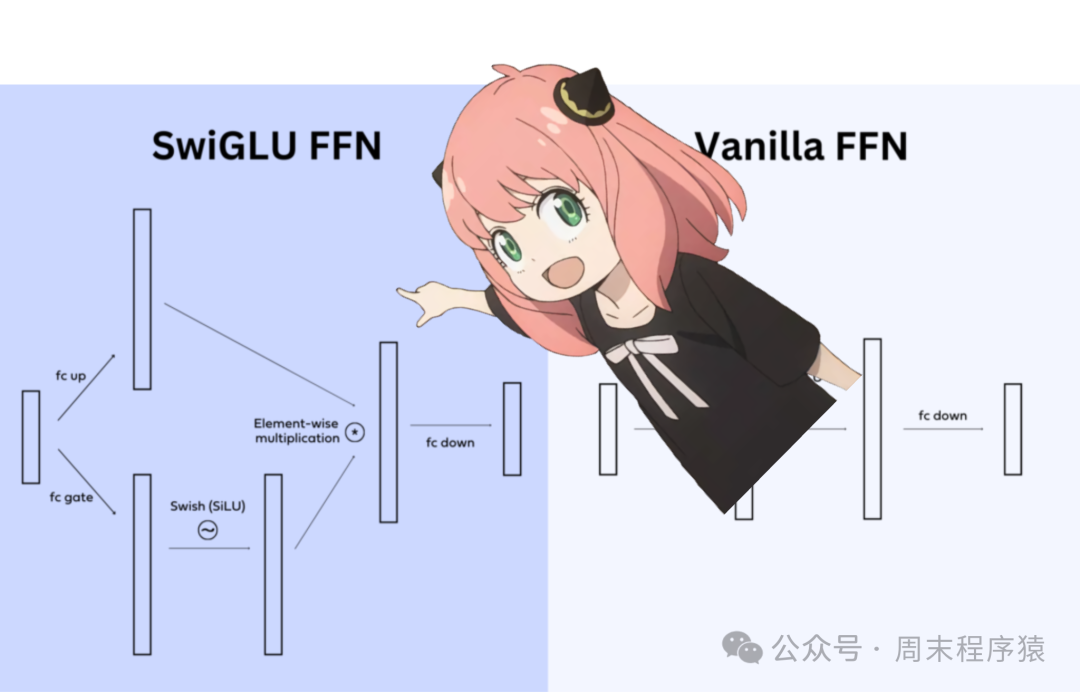
llama3-scratch
在llama3中,使用了SwiGLU前饋網(wǎng)絡(luò),這種網(wǎng)絡(luò)架構(gòu)非常適合在模型需要時(shí)添加非線性,如今,在llms中使用這種前饋網(wǎng)絡(luò)架構(gòu)相當(dāng)常見(jiàn)。
w1 = model["layers.0.feed_forward.w1.weight"]
w2 = model["layers.0.feed_forward.w2.weight"]
w3 = model["layers.0.feed_forward.w3.weight"]
output_after_feedforward = torch.matmul(torch.functional.F.silu(torch.matmul(embedding_after_edit_normalized, w1.T)) * torch.matmul(embedding_after_edit_normalized, w3.T), w2.T)
output_after_feedforward.shape
## 輸出
torch.Size([17, 4096])10、在第?層之后,終于為每個(gè)token生成新的embeding
在我們完成之前只需要再經(jīng)過(guò)31層(一個(gè) for 循環(huán)),可以想象這個(gè)生成過(guò)的embeding具有關(guān)于第一層上提出的所有查詢的信息。現(xiàn)在,對(duì)所有提出的問(wèn)題每?層都會(huì)對(duì)query進(jìn)?越來(lái)越復(fù)雜的編碼,直到得到?個(gè)embedding,其中包含了需要的下?個(gè)token的所有信息。
layer_0_embedding = embedding_after_edit+output_after_feedforward
layer_0_embedding.shape
## 輸出
torch.Size([17, 4096])for循環(huán)對(duì)每一層都執(zhí)行相同的邏輯,最終獲得final_embedding,如下所示:
final_embedding = token_embeddings_unnormalized
for layer in range(n_layers):
qkv_attention_store = []
layer_embedding_norm = rms_norm(final_embedding, model[f"layers.{layer}.attention_norm.weight"])
q_layer = model[f"layers.{layer}.attention.wq.weight"]
q_layer = q_layer.view(n_heads, q_layer.shape[0] // n_heads, dim)
k_layer = model[f"layers.{layer}.attention.wk.weight"]
k_layer = k_layer.view(n_kv_heads, k_layer.shape[0] // n_kv_heads, dim)
v_layer = model[f"layers.{layer}.attention.wv.weight"]
v_layer = v_layer.view(n_kv_heads, v_layer.shape[0] // n_kv_heads, dim)
w_layer = model[f"layers.{layer}.attention.wo.weight"]
for head in range(n_heads):
q_layer_head = q_layer[head]
k_layer_head = k_layer[head//4]
v_layer_head = v_layer[head//4]
q_per_token = torch.matmul(layer_embedding_norm, q_layer_head.T)
k_per_token = torch.matmul(layer_embedding_norm, k_layer_head.T)
v_per_token = torch.matmul(layer_embedding_norm, v_layer_head.T)
q_per_token_split_into_pairs = q_per_token.float().view(q_per_token.shape[0], -1, 2)
q_per_token_as_complex_numbers = torch.view_as_complex(q_per_token_split_into_pairs)
q_per_token_split_into_pairs_rotated = torch.view_as_real(q_per_token_as_complex_numbers * freqs_cis)
q_per_token_rotated = q_per_token_split_into_pairs_rotated.view(q_per_token.shape)
k_per_token_split_into_pairs = k_per_token.float().view(k_per_token.shape[0], -1, 2)
k_per_token_as_complex_numbers = torch.view_as_complex(k_per_token_split_into_pairs)
k_per_token_split_into_pairs_rotated = torch.view_as_real(k_per_token_as_complex_numbers * freqs_cis)
k_per_token_rotated = k_per_token_split_into_pairs_rotated.view(k_per_token.shape)
qk_per_token = torch.matmul(q_per_token_rotated, k_per_token_rotated.T)/(128)**0.5
mask = torch.full((len(token_embeddings_unnormalized), len(token_embeddings_unnormalized)), float("-inf"))
mask = torch.triu(mask, diagnotallow=1)
qk_per_token_after_masking = qk_per_token + mask
qk_per_token_after_masking_after_softmax = torch.nn.functional.softmax(qk_per_token_after_masking, dim=1).to(torch.bfloat16)
qkv_attention = torch.matmul(qk_per_token_after_masking_after_softmax, v_per_token)
qkv_attention_store.append(qkv_attention)
stacked_qkv_attention = torch.cat(qkv_attention_store, dim=-1)
w_layer = model[f"layers.{layer}.attention.wo.weight"]
embedding_delta = torch.matmul(stacked_qkv_attention, w_layer.T)
embedding_after_edit = final_embedding + embedding_delta
embedding_after_edit_normalized = rms_norm(embedding_after_edit, model[f"layers.{layer}.ffn_norm.weight"])
w1 = model[f"layers.{layer}.feed_forward.w1.weight"]
w2 = model[f"layers.{layer}.feed_forward.w2.weight"]
w3 = model[f"layers.{layer}.feed_forward.w3.weight"]
output_after_feedforward = torch.matmul(torch.functional.F.silu(torch.matmul(embedding_after_edit_normalized, w1.T)) * torch.matmul(embedding_after_edit_normalized, w3.T), w2.T)
final_embedding = embedding_after_edit+output_after_feedforward11、有了final_embedding,這是模型對(duì)下一個(gè)標(biāo)記做出的最佳猜測(cè)
embeding的形狀和token embeding的形狀相同,都是[17X4096],其中17是token的數(shù)量,4096是嵌入的維度。
final_embedding = rms_norm(final_embedding, model["norm.weight"])
final_embedding.shape
## 輸出
torch.Size([17, 4096])12、最后,讓我們將embeding解碼為token
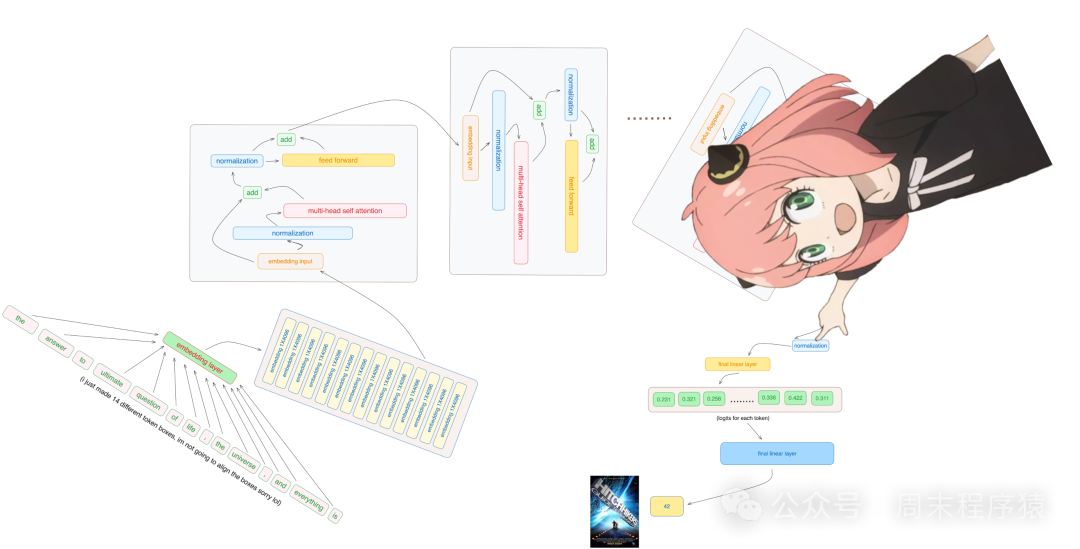
llama3-scratch
我們將使用輸出解碼器將最終的嵌入轉(zhuǎn)換為token,如下所示:
model["output.weight"].shape
## 輸出
torch.Size([128256, 4096])最終我們希望這個(gè)問(wèn)題the answer to the ultimate question of life, the universe, and everything is ,答案是42,現(xiàn)在執(zhí)行如下代碼:
logits = torch.matmul(final_embedding[-1], model["output.weight"].T)
logits.shape
## 輸出
torch.Size([128256])預(yù)測(cè)下一個(gè)token的代碼:
next_token = torch.argmax(logits, dim=-1)
next_token
## 輸出
tensor(2983)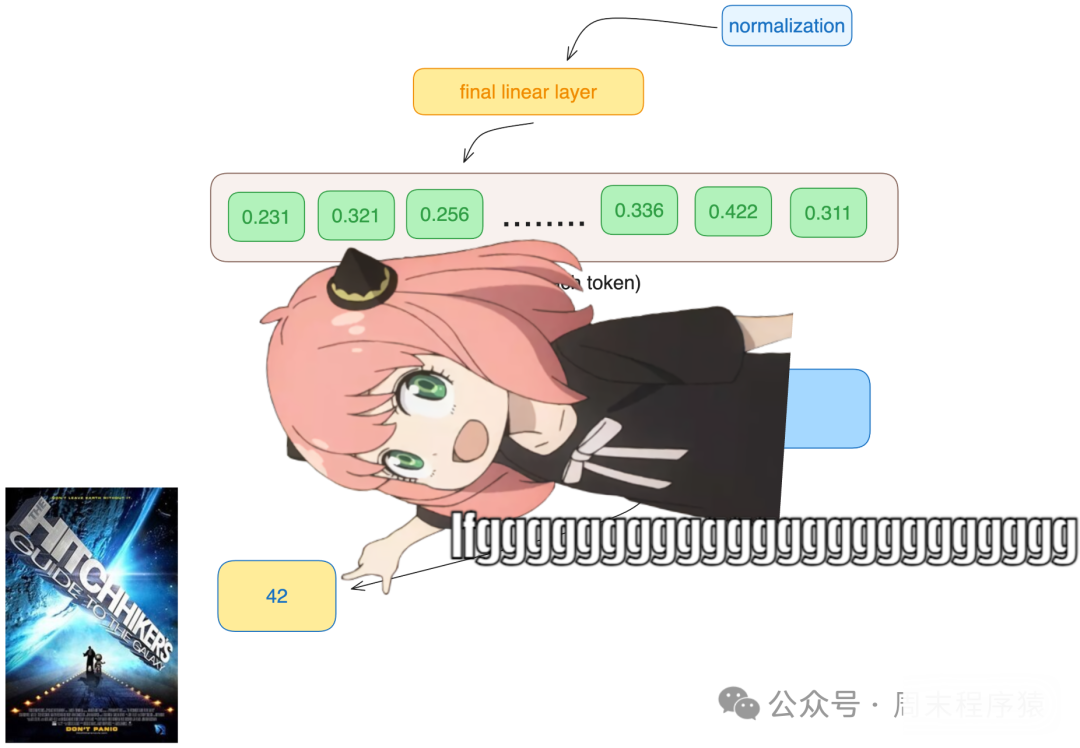
llama3-scratch
最終輸出結(jié)果:
tokenizer.decode([next_token.item()])
## 輸出
42最終我整理了一下代碼:https://github.com/linkxzhou/mylib/blob/master/llm/0-llama3-from-scratch.py
參考
(1)https://github.com/naklecha/llama3-from-scratch
本文轉(zhuǎn)載自 ??周末程序猿??,作者: 周末程序猿

















